| Author |
Message |
Kirk Lee Spencer

|
 Posted: Mon 11 Aug, 2008 9:15 am Post subject: Sica Posted: Mon 11 Aug, 2008 9:15 am Post subject: Sica |
 |
|
Hi All...
I have some cable damascus scrap a friend gave me and a nice piece of figured olive wood I found in a shop near the Church of the Holy Sepulcher in Jerusalem. I am thinking about making a Sica out of these components. I even had one of my students who is a farrier, help me to put a slight curve in the tip. However I am uncertain of the design. I have tried to find period images (mosaics mainly) and archeological finds but have had little success. So I though I would start a thread here and see if we could compile images and information about the sica.
ks
 Attachment: 98.97 KB Attachment: 98.97 KB

Two swords
Lit in Edenís flame
One of iron and one of ink
To place within a bloody hand
One of God or one of man
Our souls to one of
Two eternities
|
|
  |
 |
Kirk Lee Spencer

|
 Posted: Mon 11 Aug, 2008 9:32 am Post subject: Posted: Mon 11 Aug, 2008 9:32 am Post subject: |
 |
|
From what I have read the sica is a curved dagger. I know that during the Zealot movement in Israel in the first century, there was a really zealous faction of the Zealots who used the sica to assassinated Romans and those who supported the Roman occupation. The group was so closely associated with the sica that they became known as the sicarii.
I believe that the source of the sica takes us back to Thrace. The people of this region seemed to have an eye for curved blades.
 Attachment: 23.36 KB Attachment: 23.36 KB
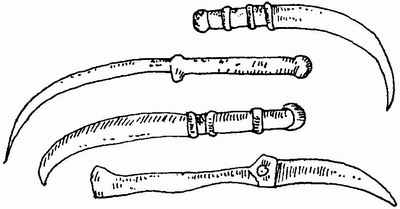
 Attachment: 9.12 KB Attachment: 9.12 KB

Two swords
Lit in Edenís flame
One of iron and one of ink
To place within a bloody hand
One of God or one of man
Our souls to one of
Two eternities
|
|
  |
 |
Kirk Lee Spencer

|
 Posted: Mon 11 Aug, 2008 9:38 am Post subject: Posted: Mon 11 Aug, 2008 9:38 am Post subject: |
 |
|
Thracian gladiators brought this curved weapon into the colosseum as something that looked like a gladius which had been bent in the middle. The idea is that the curve would allow them to strike a thrusting blow in a cutting motion around the edge of their opponents shield. I have not been able to find a period depiction or archeological find of such a weapon. However it is a very common image when showing Thracian gladiators in modern depictions.
 Attachment: 9.53 KB Attachment: 9.53 KB
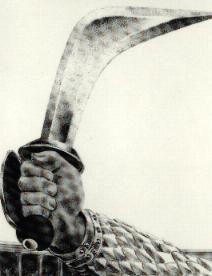
Two swords
Lit in Edenís flame
One of iron and one of ink
To place within a bloody hand
One of God or one of man
Our souls to one of
Two eternities
|
|
  |
 |
Kirk Lee Spencer

|
 Posted: Mon 11 Aug, 2008 9:50 am Post subject: Posted: Mon 11 Aug, 2008 9:50 am Post subject: |
 |
|
The largest sica I can find associated with gladiators in period images is this stone carving.
 Attachment: 88.6 KB Attachment: 88.6 KB
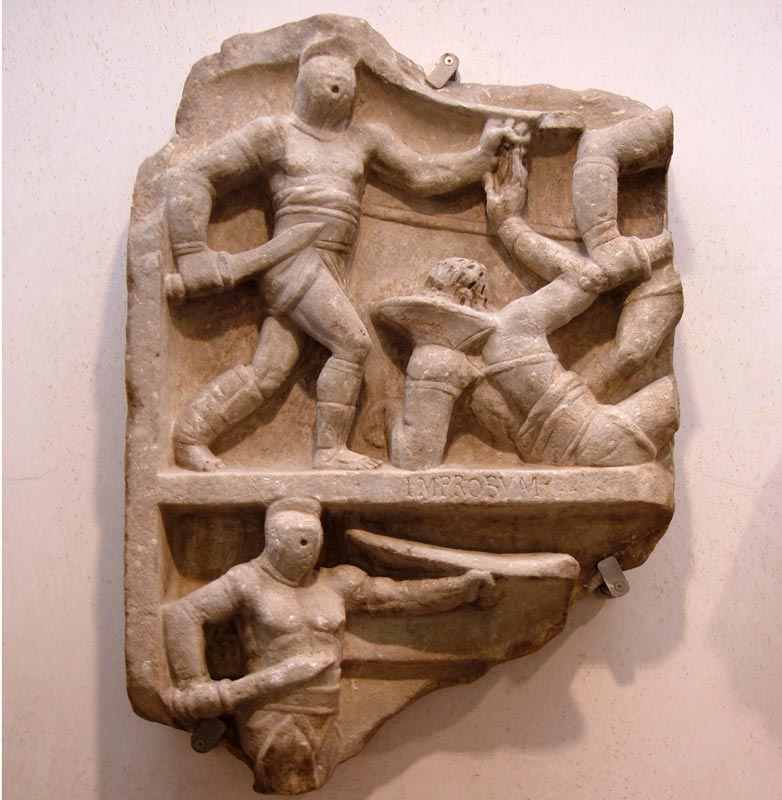
 Attachment: 89.07 KB Attachment: 89.07 KB
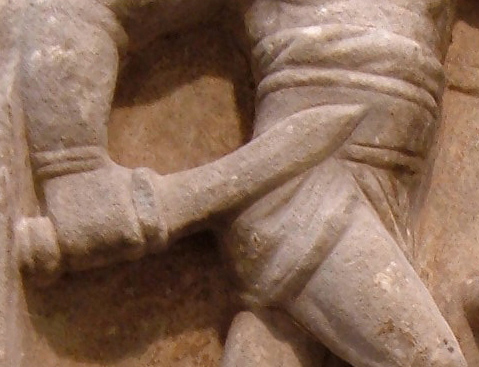
Two swords
Lit in Edenís flame
One of iron and one of ink
To place within a bloody hand
One of God or one of man
Our souls to one of
Two eternities
|
|
  |
 |
Kirk Lee Spencer

|
 Posted: Mon 11 Aug, 2008 10:10 am Post subject: Posted: Mon 11 Aug, 2008 10:10 am Post subject: |
 |
|
Other than the above weapon, the other period images I have found are of dagger proportions.
(I have not come across any actual sica finds. So if you have any information on such finds please post.)
ks
 Attachment: 99.3 KB Attachment: 99.3 KB
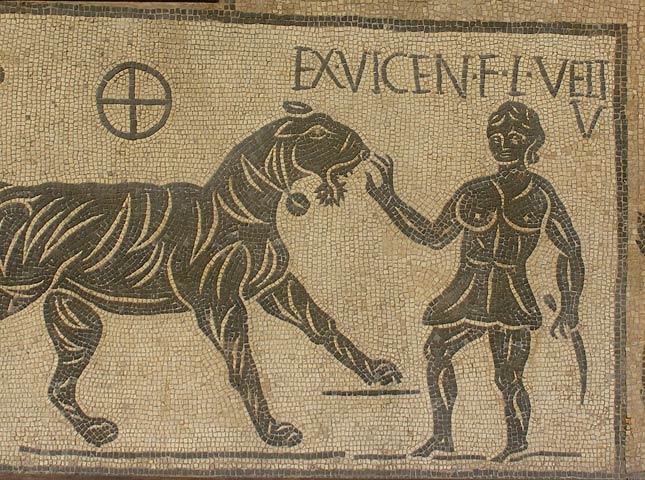
 Attachment: 97.36 KB Attachment: 97.36 KB
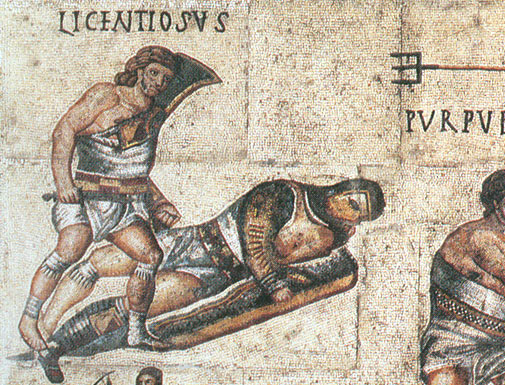
 Attachment: 84.47 KB Attachment: 84.47 KB

 Attachment: 102.13 KB Attachment: 102.13 KB

 Attachment: 101.48 KB Attachment: 101.48 KB
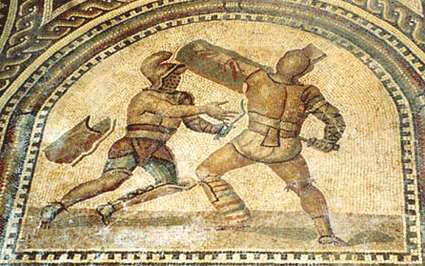
Two swords
Lit in Edenís flame
One of iron and one of ink
To place within a bloody hand
One of God or one of man
Our souls to one of
Two eternities
|
|
  |
 |
Roger Hooper

|
 Posted: Mon 11 Aug, 2008 10:36 am Post subject: Posted: Mon 11 Aug, 2008 10:36 am Post subject: |
 |
|
I've read that earlier sicas looked a lot like the Arab jambiya. Later sicas were straight blades with a kink towards the end (maybe a little like a kukri?)
 Attachment: 5.78 KB Attachment: 5.78 KB
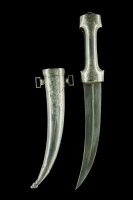
jambiya
 Attachment: 54.41 KB Attachment: 54.41 KB
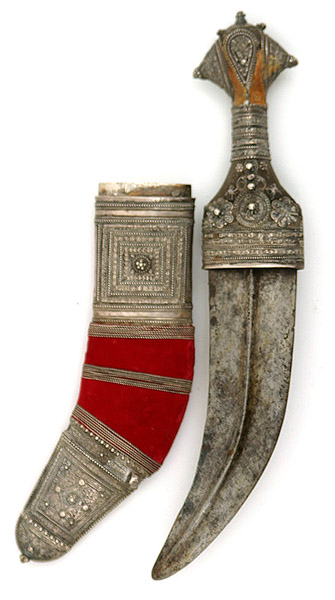
jambiya
|
|
  |
 |
Dan Howard

|
 Posted: Mon 11 Aug, 2008 2:55 pm Post subject: Posted: Mon 11 Aug, 2008 2:55 pm Post subject: |
 |
|
| Kirk Lee Spencer wrote: | | I believe that the source of the sica takes us back to Thrace. The people of this region seemed to have an eye for curved blades. |
I'd be wary of saying this. The Romans gave the sica to a gladiator called a "Thracian" but there is little to suggest that the weapon originated in the same country. I think the main difference between a sica and a kukri is the weight near the point. If the weapon is primarily intended for slashing/stabbing then it could be grouped as a sica. If it is a chopping blade then it can be grouped with the kukri.
|
|
  |
 |
|
Steve L.
|
 Posted: Thu 14 Aug, 2008 2:13 am Post subject: Posted: Thu 14 Aug, 2008 2:13 am Post subject: |
 |
|
In Romania exist a lot of finds of curved-inside-shapened-swords up to 50cm length:
http://www2.rgzm.de/Tomba1/Graves/360001/Image/360001F03.JPG
Balta Verde (Romania), dated 800-730/720 BC (early hallstatt period), iron short sword. This type was to find from romania to northern italy along the alpine "belt" from east to south west. Maybe a pre-form of the skalme!?
Sorry, i only have the pic of a replica (not from me):
http://lh4.ggpht.com/ScaryNitzi/SFWDVVnBrhI/A...imgmax=640
I donīt know from where have the romans the form of the gladiator sica. Maybe a optimal form in a "historical" shape?
I guess the pre-form of the khukri was either the makedonian kopis.
|
|
  |
 |
|
Sam Barris
|
 Posted: Thu 14 Aug, 2008 2:38 am Post subject: Posted: Thu 14 Aug, 2008 2:38 am Post subject: |
 |
|
I always thought the sica was of Dacian origin, and related to the larger falx. I seem to remember reading something about their depictions on Trajan's columns.
Pax,
Sam Barris
"Any nation that draws too great a distinction between its scholars and its warriors will have its thinking done by cowards, and its fighting done by fools." óThucydides
|
|
   |
 |
|
Danny Grigg
|
 Posted: Fri 15 Aug, 2008 7:04 am Post subject: Posted: Fri 15 Aug, 2008 7:04 am Post subject: |
 |
|
The following are from the book "The Complete Encyclopedia Of Arms & Weapons edited by Leonid Tarassuk & Claude Blair":
Sica
Greco-Roman term for a single-edged, pointed dagger, with a strongly curved blade forming a virtual right angle with the grip. Of Thraco-Illyrian origin, it was used by the Etruscans and the Ligurians, and particularly by the peoples living beyond the Rhine and the Danube. In those early time (6th-4th centuries B.C.) all weapons with curved were referred to by Greek authors as machaira or kopis. It was not until the Hellenistic period that the term sica was used, with reference to atrocities committed by the Thracians and the Illyrian foot soldiers. As early as the 1st century B.C. the term sicarii was used to describe brigands (for example, Illyrian pirates who roamed up and down the Adriatic shores) and professional assassins.
Falx Supina
(Latin, "recurving sickle"). A particular type of war knife of Oriental origin, with a curved blade and concave cutting edge, used in Roman times by Thracian gladiators. It was so named because of its shape close resembled that of a sickle. A similar weapon was developed in the western Mediterranean area, where it was considered as a sacrifical instrument and associated with various mythical figures, including Zeus striving with Typhon and Hercules fighting the Hydra of Lernia. See also HARP…
Harpť
A Greek curved sword with a large spur on the concave cutting edge of the blade; the term was applied to a large sickle-shaped knife with a concave cutting edge. It is depicted in both forms in the Perseus cycle, when the hero kills the Gorgon. In the first instance- the ensis hamatus or falcatus- it appears as a sacrifical weapon used to slaughter the bull. See also Falx Supina.
Machaira
A single-edged, pointed war knife, carried by warriors in Homer's day and later, slung from a baldric or sword belt alongside the double-edged sword, the XIPHOS. Authors writing after the Homeric period tended to confuse the two terms and sometimes even muddled them with KOPIS as well. The machaira was used by both infantry and cavalry. In fact, the Athenian historian and military chief Xenophon (c. 434-c. 355 B.C.) urged the cavalry to use the machaira instead of the sword because its cutting potential was greater. The machaira is distinct typologically from the kopis, which had a considerably more accentuated curvature and a concave cutting edge. It was also used for slaying sacrifical victims and for domestic uses. Among Latin authors, the term "machaira" is used to describe a single-edged, pointed sword for use with one or both hands. After the second Punic War (218-201 B.C.), it was issued to special corps known as machairofůroi.
Kopis
The etymology of this term is from the Greek kopto, meaning "cut". The word indicates a weapon designed for cutting blows. It is of nonclassical derivation, and there is evidence of this weapon in Greece among the remains of vanguished foreigners. It is often associated with the MACHAIRA, which was a war knife with a curved blade; but the two types can be distinguised by observing the curvature of the cutting edge of the blade: concave for the kopis, convex for the machaira. A version that combined features from both weapons was probably known as the "kopis-machaira". It was in use in ancient Greece and was depicted on vase paintings.
Romphaea
A classical Greek staff weapon of Thracian-Illyrian origin; it was more than 2 m. (6Ĺ ft.) long with a large head in the form of a curved, double-edged blade (like the HARP… or SICA curved daggers), which was mounted on a sturdy shaft.
Please excuse any spelling mistakes I've made transcribing the above from the book.
The book contains drawings of the Harpť, Machaira & Kopis, but not the Sica, Falx Supina or Romphaea.
Based on the above the following links would be examples of the Sica and Falx Supina:
http://www.hermann-historica.de/auktion/hhm54...at54_g.txt
http://www.hermann-historica.de/auktion/hhm54...at54_g.txt
http://www.hermann-historica.de/auktion/hhm54...at54_g.txt
http://www.gk.ro/sarmizegetusa/ranistorum/site_eng/fierul.html
http://www.learmideiromani.it/htm/varie.htm
http://www.swordsmith.net/roman.asp?gallery=r...=162#Items
http://www.swordsmith.net/roman.asp?gallery=r...=163#Items
http://www.swordsmith.net/roman.asp?gallery=roman&id=75#Items
http://153162.aceboard.fr/153162-1184-7330-0-...glaive.htm
http://www.stoa.org/trajan/buildtrajanpage.cgi?349
http://www.stoa.org/trajan/buildtrajanpage.cgi?359
http://www.flickr.com/search/?q=thraex&w=all
http://www.flickr.com/photos/smithco/143092783/
http://www.flickr.com/photos/kjfnjy/224054839/
http://www.flickr.com/photos/jungle_boy/201194260/
I hope all of this is helpful.
Danny
|
|
  |
 |
Kirk Lee Spencer

|
 Posted: Mon 18 Aug, 2008 10:21 am Post subject: Posted: Mon 18 Aug, 2008 10:21 am Post subject: |
 |
|
Hey Danny....
Excellent stuff!
Thanks 
ks
Two swords
Lit in Edenís flame
One of iron and one of ink
To place within a bloody hand
One of God or one of man
Our souls to one of
Two eternities
|
|
  |
 |
Kirk Lee Spencer

|
 Posted: Sat 30 Aug, 2008 6:56 pm Post subject: Posted: Sat 30 Aug, 2008 6:56 pm Post subject: |
 |
|
Here is a sica-like curved dagger from a tomb in Alexandrovo, Bulgaria. It is dated to the 4th Century B.C.
 Attachment: 7.01 KB Attachment: 7.01 KB

Two swords
Lit in Edenís flame
One of iron and one of ink
To place within a bloody hand
One of God or one of man
Our souls to one of
Two eternities
|
|
  |
 |
|
Carl Goff
|
 Posted: Sun 31 Aug, 2008 2:22 pm Post subject: Posted: Sun 31 Aug, 2008 2:22 pm Post subject: |
 |
|
Minor contribution.
The sica was supposedly popular with many of the political street gangs of the Late Republic.
Oh, East of sands and sunlit gulf, your blood is thin, your gods are few;
You could not break the Northern wolf and now the wolf has turned on you.
The fires that light the coasts of Spain fling shadows on the Eastern strand.
Master, your slave has come again with torch and axe in his right hand!
-Robert E. Howard
|
|
  |
 |
Dan Howard

|
 Posted: Sun 31 Aug, 2008 5:36 pm Post subject: Posted: Sun 31 Aug, 2008 5:36 pm Post subject: |
 |
|
|
It was the switchblade of the ancient world. It could be worn under the tunic up near the armpit. It could be drawn by pulling it through the armhole of the tunic and resheathed the same way without anyone noticing.
|
|
  |
 |
Romulus Stoica

Location: Hunedoara, Transylvania, Romania Joined: 26 Oct 2006
Posts: 124
|
 Posted: Tue 02 Sep, 2008 1:16 am Post subject: Posted: Tue 02 Sep, 2008 1:16 am Post subject: |
 |
|
Hello! I haven't posted much on this forum, tough I am lurking in here for more than an year  . .
About the sica dagger, I can tell you quite a lot since it was a typical weapon of the dacians that lived in what is now Romania. More than that, two sica daggers were found here in my home town, Hunedoara, near to the dacian capital, Sarmisegetusa Regia.
This weapon came in a variety of sizes, from small ones, about 30 cm (~12 inches) long, to larger ones, about 45-50 cm long (~ 18 - 20 inches) total length, including the handle. Usually has the shape of a claw and was decorated with a star or a sun in between a pair of wings on the middle of the blade. I will try to obtain a picture of the best preserved one found here in Hunedoara. It was a small one
|
|
   |
 |
Kirk Lee Spencer

|
 Posted: Wed 03 Sep, 2008 3:19 pm Post subject: Posted: Wed 03 Sep, 2008 3:19 pm Post subject: |
 |
|
Hey Romulus...
It's good to hear from you!
Thanks for the information. That would be great to see a picture of an original find. So far most of what I am finding are mosaic images that show very little detail.
However, I did run across a Roman oil lamp showing a gladiator holding a sica. (From what I have heard these gladiator lamps were quite popular.) The figure on the ground holds a sica with a blade bent like a claw.
take care
ks
 Attachment: 99.9 KB Attachment: 99.9 KB
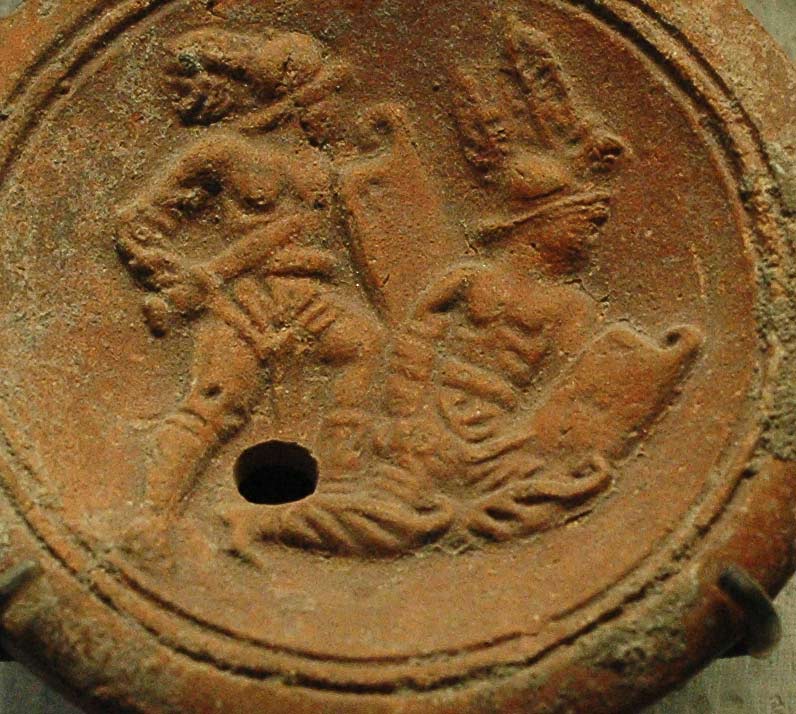
Two swords
Lit in Edenís flame
One of iron and one of ink
To place within a bloody hand
One of God or one of man
Our souls to one of
Two eternities
|
|
  |
 |
Kirk Lee Spencer

|
 Posted: Sat 15 Aug, 2009 7:37 pm Post subject: Posted: Sat 15 Aug, 2009 7:37 pm Post subject: |
 |
|
Some more gladiator lamps showing sica in hand.
ks
 Attachment: 147.83 KB Attachment: 147.83 KB
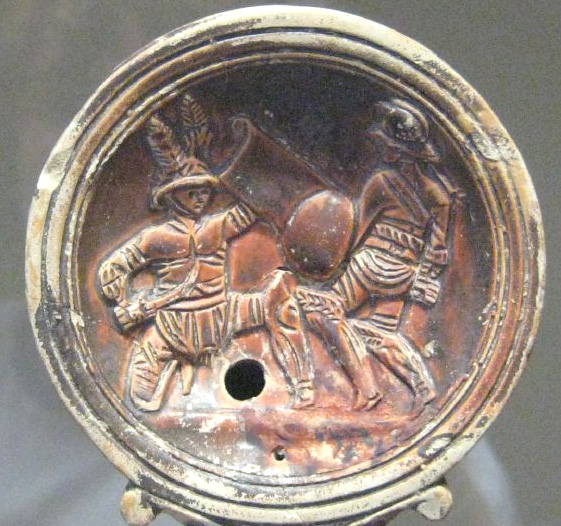
 Attachment: 125.41 KB Attachment: 125.41 KB
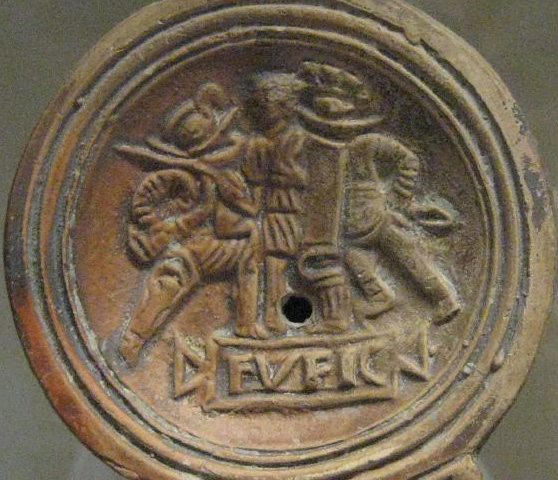
Two swords
Lit in Edenís flame
One of iron and one of ink
To place within a bloody hand
One of God or one of man
Our souls to one of
Two eternities
|
|
  |
 |
Kirk Lee Spencer

|
 Posted: Sat 15 Aug, 2009 7:41 pm Post subject: Posted: Sat 15 Aug, 2009 7:41 pm Post subject: |
 |
|
Here is the carved bone handle on a Thracian folding knife showing a gladiator with sica.
ks
 Attachment: 146.21 KB Attachment: 146.21 KB
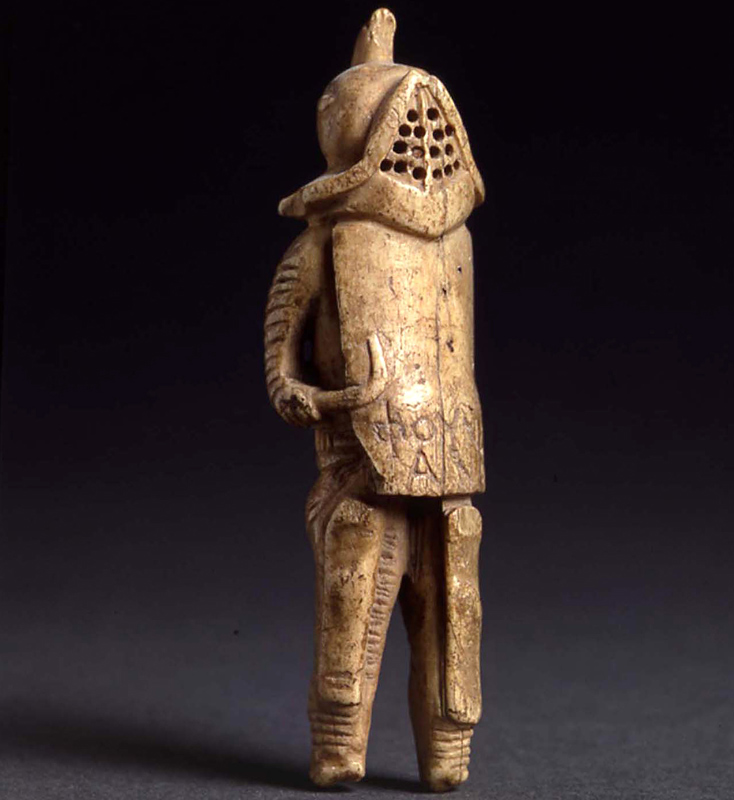
 Attachment: 143.61 KB Attachment: 143.61 KB
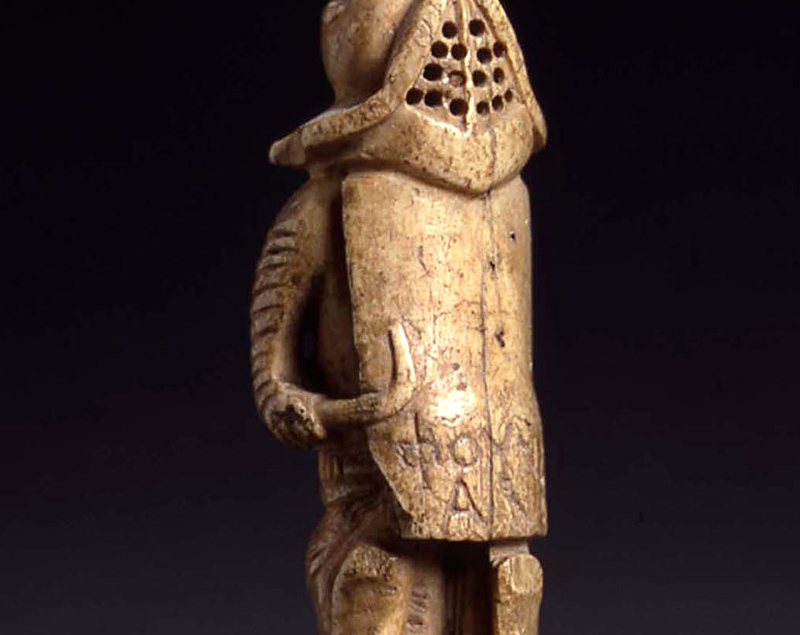
Two swords
Lit in Edenís flame
One of iron and one of ink
To place within a bloody hand
One of God or one of man
Our souls to one of
Two eternities
|
|
  |
 |
|
Luke Zechman
Location: Lock Haven Pennsylvania Joined: 18 Jan 2009
Posts: 278
|
 Posted: Fri 08 Jan, 2010 10:44 pm Post subject: Posted: Fri 08 Jan, 2010 10:44 pm Post subject: |
 |
|
Kirk,
I was wondering if you had any further information in the "sica" pictured in the second post of this thread? I feel like I have recently seen this piece somewhere on the web in my recent infatuation with these type of blades. Can't remember where I saw it but if it was the same one then it was sold at an auction.
|
|
  |
 |
Kirk Lee Spencer

|
 Posted: Sun 10 Jan, 2010 2:45 pm Post subject: Posted: Sun 10 Jan, 2010 2:45 pm Post subject: |
 |
|
| Luke Zechman wrote: | Kirk,
I was wondering if you had any further information in the "sica" pictured in the second post of this thread?... |
Hey Luke...
Sorry I don't have any information on it. I do have a closer shot of the grip.
ks
 Attachment: 15.04 KB Attachment: 15.04 KB
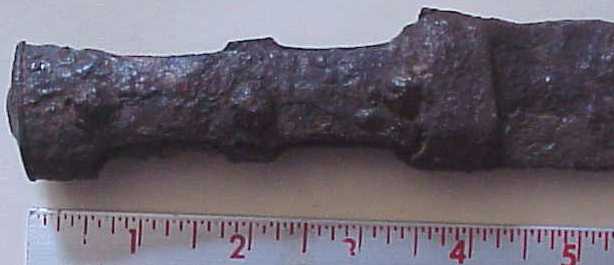
Two swords
Lit in Edenís flame
One of iron and one of ink
To place within a bloody hand
One of God or one of man
Our souls to one of
Two eternities
|
|
  |
 |
|
|

